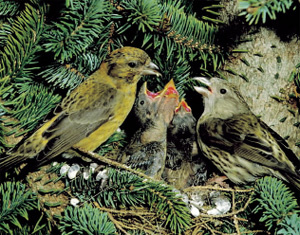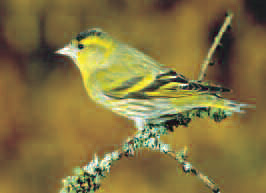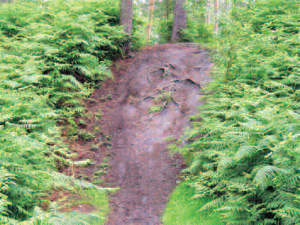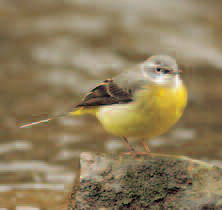Fairoak Valley is a rich and important
habitat that is home to many wildlife
species. The Forestry Commission manages
this area with great sensitivity to help
conserve and enhance its special features
for future generations.
The area has an interesting coal mining
past and was the location of a colliery in
the late 19th century.

The crossbill, Loxia curvirostra, is a type of finch. Its
hooked bill is crossed over at the tips, which helps
it to extract seeds from conifer cones. You might
spot a crossbill in this area fluttering from cone to
cone, or flying at treetop height in family groups or
larger flocks
The forest
Cannock Chase is predominantly a pine forest of
mostly Corsican pine, with larch and broadleaf
trees adding diversity. Pine trees provide shelter
and homes for birds such as siskins and
goldcrest, and shelter for animals such as deer.
Dead trees are left where they fall to provide a
habitat for insects, mammals, and birds
including owls, buzzards and woodpeckers.

The great spotted woodpecker, Dendrocopus
major. In spring you might hear the male
bird displaying its territory by drumming on
tree-trunks. They are not always making a
hole, but woodpeckers do use their bill to
make holes for nesting and to probe
decaying wood for insect larvae
Photograph by Chris Blackburn

The siskin, Carduelis spinus, is a member of
the finch family. The male, shown here, has
streaky yellow–green plumage and a black
crown and bib

Red, muntjac and fallow deer are all established on Cannock
Chase. Fallow deer, shown here, are the most common.
Photograph by Chris Blackburn

The foxglove, Digitalis purpurea, flowers from June to September. Look out for it in woodland areas
Image courtesy of Cannock Chase AONB Unit

The adder, Vipera berus, is found on heathland
areas and at the edge of woodlands on Cannock
Chase. Adders are cold–blooded. You might see
them raising their body temperature by basking in
the warm early-morning sunshine.
Image courtesy of Mark Hamblin (rspb-images.com)
|

Mallards, Anas platyrhynchos, are a duck species
that enjoy wetland habitats such as Fairoak Pools.
Their varied diet includes seeds, acorns, berries,
plants, insects and shellfish

The comma, Polygonia c-album, named after
a white mark on the under side of its wing,
is one of the first species of butterfly to be
seen in the spring.
Image courtesy of Andy Jukes
Wetland habitats
Fairoak Valley includes Stony Brook and Fairoak Pools,
the largest water bodies on Cannock Chase. These pools
are linked together by a stream system, which sources
from underground springs at the top of the valley.
The wetlands and surrounding habitats encourage
amphibians such as frogs, toads, newts (including great
crested newts), snakes (grass and adder) and common
lizards. Herons and water fowl such as Canada geese,
mallard, tufted ducks and coot can all be seen here.
Of the species of bat that can be found on Cannock
Chase, three species (daubenton’s, brown long-eared
and piperstrelle) are attracted to the wetlands in this
area. You might notice bat boxes on pine trees
throughout the forest.
|
|
|
Despite its name, the most striking
feature of the grey wagtail, Motacilla
cinerea, is its lemon yellow undertail.
You might see them here around
brooks and streams.
Photograph by Chris Blackburn |
|
You might see a grey heron, Ardea
cinerea, standing motionless for hours
as it watches for food. |

This trail passes close to wildlife sites of
international importance. Cycle wheels,
horse hooves, and feet, can severely
damage these sites, and out of control
dogs disturb wildlife. Please help us to
protect wildlife by remaining on
designated routes and by keeping dogs
under close control
|
The Fair Oak Colliery Company was
formed on 1 September 1871. It
acquired a 60 year lease on 5,500
acres of mineral rights under
Cannock Chase, but crucially, the
company had not sunk a bore-hole
to test the geology of the area.
On January 1st 1872 work began on the two
shafts of No 1 Plant, on the opposite side of
Stony Brook. The workmen immediately ran
into problems. Dynamite was needed to blast
through layers of sand and gravel, and water
needed to be pumped away. The rocks serving
as stepping stones over Stony Brook and other
rocks in the dam walls of Fairoak pools came
from these shafts.
No 1 Plant failed to yield any coal and was
eventually abandoned in 1875. The company
was more successful with its No 2 Plant, which
began to produce coal in 1877. This was about
750 metres south west of here, near to the top
of Jockey Hill.
By 1880 the colliery was producing 2,000 tons
of coal per week and employed almost 400
people. Workmen and their families were
housed in two rows of cottages and a few
houses close to Stony Brook. But the cost of
unproductive years had taken its toll, and in
1884 mining operations ended. Company
liquidation soon followed.
|
The nearby spoil mounds and the excavated rocks in the brook are all that remains of this short-lived but once thriving colliery.

The spoil heap of Fair Oak Colliery Company’s No 1 Pit, one
of the few remaining signs that a colliery once operated
near here.
|












